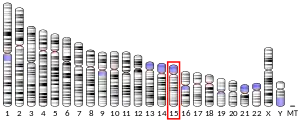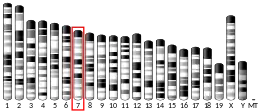Selenoprotein S, also known as SELS, is a human gene.[5]
This gene encodes a selenoprotein, which contains a selenocysteine (Sec) residue at its active site. The selenocysteine is encoded by the UGA codon that normally signals translation termination. The 3' UTR of selenoprotein genes have a common stem-loop structure, the sec insertion sequence (SECIS), that is necessary for the recognition of UGA as a Sec codon rather than as a stop signal. Studies suggest that this protein may regulate cytokine production, and thus play a key role in the control of the inflammatory response. Two alternatively spliced transcript variants encoding the same protein have been found for this gene.[5]
Interactions
SELS (gene) has been shown to interact with Valosin-containing protein.[6][7]
References
- 1 2 3 GRCh38: Ensembl release 89: ENSG00000131871 - Ensembl, May 2017
- 1 2 3 GRCm38: Ensembl release 89: ENSMUSG00000075701 - Ensembl, May 2017
- ↑ "Human PubMed Reference:". National Center for Biotechnology Information, U.S. National Library of Medicine.
- ↑ "Mouse PubMed Reference:". National Center for Biotechnology Information, U.S. National Library of Medicine.
- 1 2 "Entrez Gene: SELS selenoprotein S".
- ↑ Ye, Yihong; Shibata Yoko; Yun Chi; Ron David; Rapoport Tom A (Jun 2004). "A membrane protein complex mediates retro-translocation from the ER lumen into the cytosol". Nature. 429 (6994): 841–847. Bibcode:2004Natur.429..841Y. doi:10.1038/nature02656. PMID 15215856. S2CID 4317750.
- ↑ Wang, Qiuyan; Li Lianyun; Ye Yihong (Mar 2008). "Inhibition of p97-dependent Protein Degradation by Eeyarestatin I". J. Biol. Chem. 283 (12): 7445–7454. doi:10.1074/jbc.M708347200. ISSN 0021-9258. PMC 2276333. PMID 18199748.
Further reading
- Robertson NG, Khetarpal U, Gutiérrez-Espeleta GA, et al. (1995). "Isolation of novel and known genes from a human fetal cochlear cDNA library using subtractive hybridization and differential screening". Genomics. 23 (1): 42–50. doi:10.1006/geno.1994.1457. PMID 7829101.
- Maruyama K; Sugano S (1994). "Oligo-capping: a simple method to replace the cap structure of eukaryotic mRNAs with oligoribonucleotides". Gene. 138 (1–2): 171–174. doi:10.1016/0378-1119(94)90802-8. PMID 8125298.
- Bonaldo MF; Lennon G; Soares MB (1997). "Normalization and subtraction: two approaches to facilitate gene discovery". Genome Res. 6 (9): 791–806. doi:10.1101/gr.6.9.791. PMID 8889548.
- Suzuki Y, Yoshitomo-Nakagawa K, Maruyama K, et al. (1997). "Construction and characterization of a full length-enriched and a 5'-end-enriched cDNA library". Gene. 200 (1–2): 149–156. doi:10.1016/S0378-1119(97)00411-3. PMID 9373149.
- Hu RM, Han ZG, Song HD, et al. (2000). "Gene expression profiling in the human hypothalamus-pituitary-adrenal axis and full-length cDNA cloning". Proc. Natl. Acad. Sci. U.S.A. 97 (17): 9543–9548. Bibcode:2000PNAS...97.9543H. doi:10.1073/pnas.160270997. PMC 16901. PMID 10931946.
- Walder K, Kantham L, McMillan JS, et al. (2002). "Tanis: a link between type 2 diabetes and inflammation?". Diabetes. 51 (6): 1859–1866. doi:10.2337/diabetes.51.6.1859. PMID 12031974.
- Strausberg RL, Feingold EA, Grouse LH, et al. (2003). "Generation and initial analysis of more than 15,000 full-length human and mouse cDNA sequences". Proc. Natl. Acad. Sci. U.S.A. 99 (26): 16899–16903. Bibcode:2002PNAS...9916899M. doi:10.1073/pnas.242603899. PMC 139241. PMID 12477932.
- Gao Y, Walder K, Sunderland T, et al. (2003). "Elevation in Tanis expression alters glucose metabolism and insulin sensitivity in H4IIE cells". Diabetes. 52 (4): 929–934. doi:10.2337/diabetes.52.4.929. PMID 12663463.
- Kryukov GV, Castellano S, Novoselov SV, et al. (2003). "Characterization of mammalian selenoproteomes". Science. 300 (5624): 1439–1443. Bibcode:2003Sci...300.1439K. doi:10.1126/science.1083516. PMID 12775843. S2CID 10363908.
- Ota T, Suzuki Y, Nishikawa T, et al. (2004). "Complete sequencing and characterization of 21,243 full-length human cDNAs". Nat. Genet. 36 (1): 40–45. doi:10.1038/ng1285. PMID 14702039.
- Gao Y, Feng HC, Walder K, et al. (2004). "Regulation of the selenoprotein SelS by glucose deprivation and endoplasmic reticulum stress - SelS is a novel glucose-regulated protein". FEBS Lett. 563 (1–3): 185–190. doi:10.1016/S0014-5793(04)00296-0. hdl:10536/DRO/DU:30002457. PMID 15063746. S2CID 45977972.
- Karlsson HK, Tsuchida H, Lake S, et al. (2004). "Relationship between serum amyloid A level and Tanis/SelS mRNA expression in skeletal muscle and adipose tissue from healthy and type 2 diabetic subjects". Diabetes. 53 (6): 1424–1428. doi:10.2337/diabetes.53.6.1424. PMID 15161744.
- Ye Y, Shibata Y, Yun C, et al. (2004). "A membrane protein complex mediates retro-translocation from the ER lumen into the cytosol". Nature. 429 (6994): 841–847. Bibcode:2004Natur.429..841Y. doi:10.1038/nature02656. PMID 15215856. S2CID 4317750.
- Gerhard DS, Wagner L, Feingold EA, et al. (2004). "The Status, Quality, and Expansion of the NIH Full-Length cDNA Project: The Mammalian Gene Collection (MGC)". Genome Res. 14 (10B): 2121–2127. doi:10.1101/gr.2596504. PMC 528928. PMID 15489334.
- Lilley BN; Ploegh HL (2006). "Multiprotein complexes that link dislocation, ubiquitination, and extraction of misfolded proteins from the endoplasmic reticulum membrane". Proc. Natl. Acad. Sci. U.S.A. 102 (40): 14296–14301. doi:10.1073/pnas.0505014102. PMC 1242303. PMID 16186509.
- Ye Y, Shibata Y, Kikkert M, et al. (2006). "Recruitment of the p97 ATPase and ubiquitin ligases to the site of retrotranslocation at the endoplasmic reticulum membrane". Proc. Natl. Acad. Sci. U.S.A. 102 (40): 14132–14138. doi:10.1073/pnas.0505006102. PMC 1242302. PMID 16186510.
- Curran JE, Jowett JB, Elliott KS, et al. (2006). "Genetic variation in selenoprotein S influences inflammatory response". Nat. Genet. 37 (11): 1234–1241. doi:10.1038/ng1655. hdl:10536/DRO/DU:30006596. PMID 16227999. S2CID 19184873.
- Gao Y, Hannan NR, Wanyonyi S, et al. (2006). "Activation of the selenoprotein SEPS1 gene expression by pro-inflammatory cytokines in HepG2 cells". Cytokine. 33 (5): 246–251. doi:10.1016/j.cyto.2006.02.005. PMID 16574427.
- Gao Y, Pagnon J, Feng HC, et al. (2007). "Secretion of the glucose-regulated selenoprotein SEPS1 from hepatoma cells". Biochem. Biophys. Res. Commun. 356 (3): 636–641. doi:10.1016/j.bbrc.2007.03.018. PMID 17374524.
- Seiderer J, Dambacher J, Kühnlein B, et al. (2007). "The role of the selenoprotein S (SELS) gene -105G>A promoter polymorphism in inflammatory bowel disease and regulation of SELS gene expression in intestinal inflammation". Tissue Antigens. 70 (3): 238–246. doi:10.1111/j.1399-0039.2007.00888.x. PMID 17661913.





